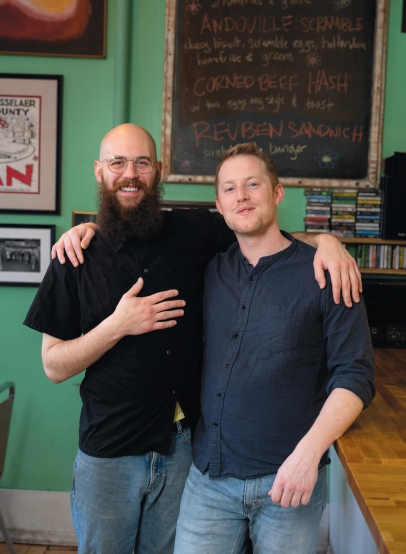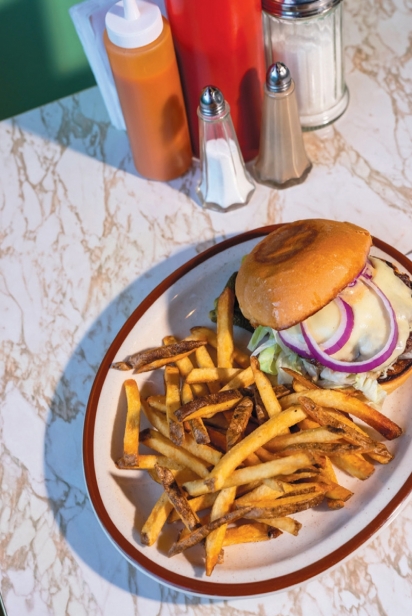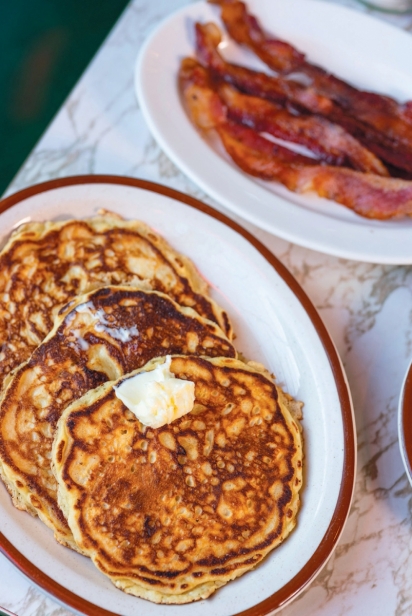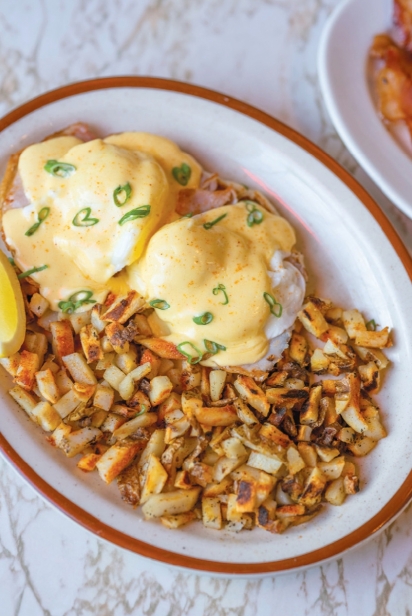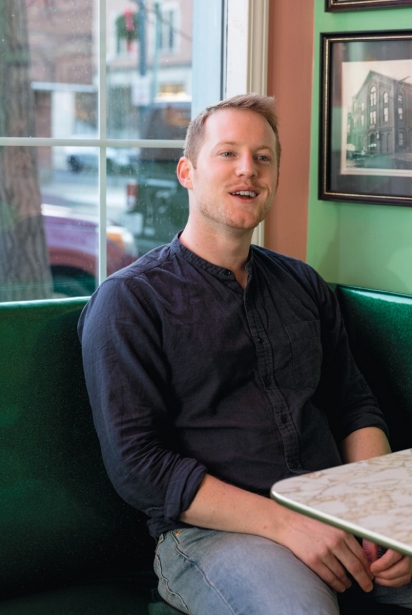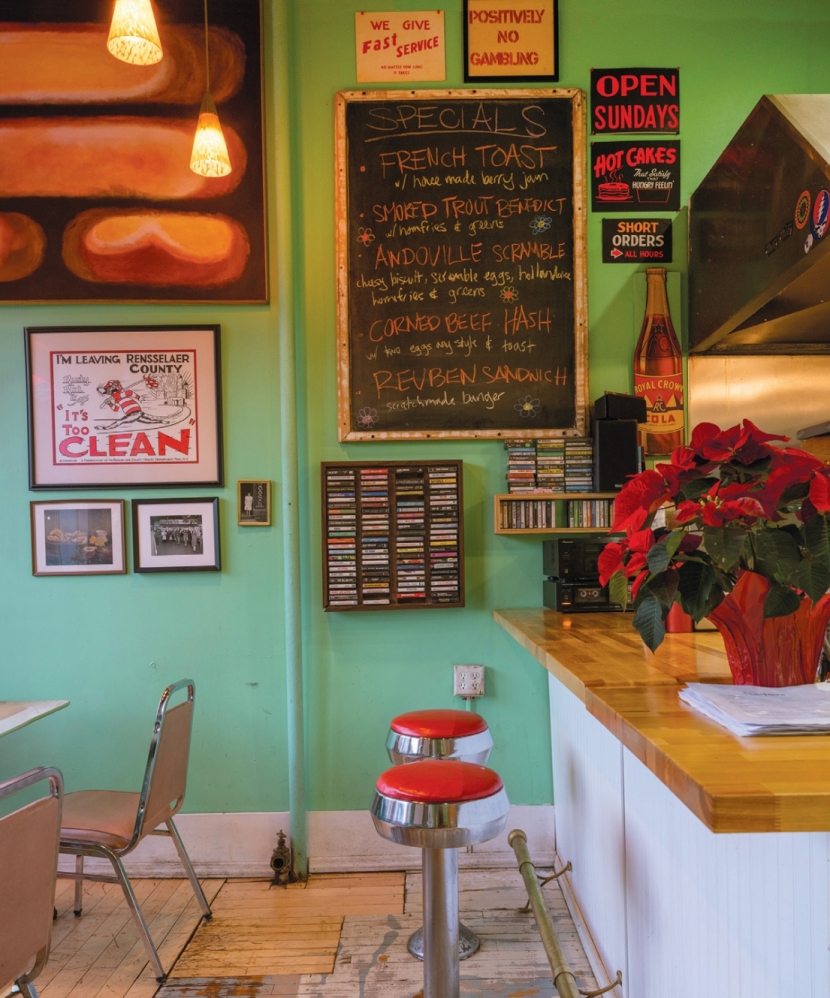Naughter's Has Saved a (Third) Space for You
Many of us, despite likely never actually experiencing what we would characterize as a “simple” life, long for a time and place where such a thing exists. (It seems to be a permanent side effect of the human condition.)
Common sense tells us that if we traveled back in time before the advent of the smartphone, when the idea of instituting a “digital cleanse” would have seemed comical at best and physically threatening at worst, there we would also have to contend with some of the benighted attitudes and problematic paradigms that characterize everyday life.
And if we beamed our lives to a remote patch of land far, far away from here to pursue a more pared-down life, we’d likely have to say “farewell” to most of, if not all of, our loved ones, employers, Wi-Fi, craft beer and half-decent bagels.
If only there were a place where we could go to temporarily visit a simpler time and place. That is precisely what John Naughter was attempting to create when he opened Naughter’s in Troy on February 14, 2022. Call it a Valentine to a certain kind of community life.
“I wanted to create a third space,” Naughter says. “The food is important, but it’s almost secondary to the spirit of the space. We are losing these third spaces, especially affordable ones that welcome people from all walks of life.”
A Communal Space
The urban sociologist Ray Oldenburg coined the phrases “third spaces” and “third places” and used them interchangeably in his 1989 book The Great Good Place. Oldenburg argued that these places—often bars, coffee shops and general stores—serve our democracy and individual communities.
Home, by the way, is the “first” place, and work is the “second.” That third place, Oldenburg argues, is where individuals can publicly relax and authentically interact with people they don’t live or work with.
Third spaces are where you might become a “regular” and interact with the bartenders, line cooks or managers who run the show. Light social interaction—whether indirect or overt—between strangers and acquaintances defines these spaces.
Remember chatting? Third spaces are where this sort of thing still occurs between humans.
In May of 2023, United States Surgeon General Dr. Vivek Murthy dubbed loneliness and lack of connection a “public health crisis.” We’re in an era when loneliness is on the rise, and the mental and physical consequences associated with loneliness assault not just the individuals it affects but everyone around them, making third places not just convenient assets but essential aspects of modern life.
Naughter’s is more than just a paean to an era and a place where folks can gather to get great eggs and a warm seat and maybe shoot the breeze in the process. It is a sort of conceptual socioeconomic model and way of living that Naughter also feels is endangered.
“Is it even possible anymore to run a humble diner-style restaurant and live a middle-class life?” Naughter asks rhetorically. “Is it possible to serve affordable food to everyone from retirees on a budget to high school kids to homeless people? I wanted to try.”
Naughter, who is now in his early 30s, has spent most of his life in restaurants.
“I’ve done delivery work, I’ve cooked in vegan restaurants, I’ve worked as a barback, I’ve done dishes,” he says. “I’ve also worked as a cook at really nice restaurants in Troy. But mostly, I’ve spent many years cooking eggs and burgers all night until 5 a.m.”
Naughter has also, he explains, worked countless brunch shifts.
“I wanted to open my doors for breakfast and late-night eaters,” Naughter says. “Those are the most endangered times for third spaces. Really late nights and early mornings. In my mind, coffee shops should be open until midnight. There should be a place that isn’t a bar for people to gather and work on their own, or read, or hang out.”
“The food is important, but it’s almost secondary to the spirit of the space. We are losing these third spaces, especially affordable ones that welcome people from all walks of life.”
—John Naughter
During the pandemic, Naughter created a late-night pop-up called “Industry Eggplant” within one of his alma maters, Burrito Burrito. He served an addictive vegan sandwich that became a late-night cause célèbre among plant afficionados and devoted carnivores alike. It featured perfectly salted and fried eggplant, cherry peppers, roasted red peppers, crunchy iceberg lettuce and crisp hash browns on a bun with a generous dollop of herby pesto mayo. During that dark time, Naughter perfected the sandwich, which also appears on his current menu, and the concept of what he wanted to create.
“I put my life savings, which wasn’t a ton, into the place,” he says. “My grandmother and mother helped a bit, too. I didn’t want investors or partners. I didn’t want anyone making decisions except me.”
“I wanted to open my doors for breakfast and late-night eaters,” Naughter says. “Those are the most endangered times for third spaces. Really late nights and early mornings. In my mind, coffee shops should be open until midnight. There should be a place that isn’t a bar for people to gather and work on their own, or read, or hang out.”
A Communal Effort
What has made the experiment a success—aside from the essential gap it fills in the community and the great food—is Naughter’s team of cooks.
“These chefs—Ryan Charbonneau and Aaron Meda during the day and Justin Durand at night—are extremely talented and could have much fancier jobs,” Naughter says. “But they do it because they’re also passionate about creating an alternative space in Troy.”
And the cooks, he adds, do much more than cook.
Indeed, when you walk into Naughter’s, which seats around 20 between the vintage vinyl booths and row of stools at the counter, the first thing you see is two line cooks flipping eggs, bacon and burgers under a gleaming silver hood festooned with stickers that say things like: “Employees must scream for vengeance before returning to work.”
There is also a person working the register, welcoming and seating people and maintaining the kind of merry chaotic order that should define every space: first, second and third. There is a collection of tapes—remember those?—featuring a Who’s Who of yours, your inner child’s and your future grandchild’s favorite tunes: Aerosmith, Genesis, Donna Summer, Ramones, Mötley Crüe, Jackson Browne.
Service is fast, and the food can be comfortably purchased by everyone from the mayor (who frequents Naughter’s, too) to broke students and tried-and-true penny pinchers.
“I know what it’s like as a longtime line cook myself, and it was really important for me to be able to create a space where everyone could afford coffee and a meal,” Naughter says.
In addition to a crisis of loneliness and a disturbing disappearance of community, Americans are contending with increasingly complex financial challenges. While household incomes overall have gone up considerably since 1970, lower- and middle-income Americans have not enjoyed the same spike that upper-income Americans have, according to comprehensive research from the Pew Research Center, a nonpartisan fact tank.
Indeed, when you walk into Naughter’s, which seats around 20 between the vintage vinyl booths and row of stools at the counter, the first thing you see is two line cooks flipping eggs, bacon and burgers under a gleaming silver hood festooned with stickers that say things like: “Employees must scream for vengeance before returning to work.”
The share of adults living in what can be broadly considered middle-class households fell from 61% in 1971 to 50% in 2021, according to the Pew Research Center’s analysis of government data. The gap between people in the middle- and upper-income brackets is getting wider. As of 2020, middle income folks held 42% of the country’s aggregate income, versus 62% in 1970.
In 2020, the median income of upper-income households was 7.3 times that of lower-income households, up from 6.3 in 1970, Pew reports. The gap between upper- and middle-income households rose from 2.2 to 2.4 times higher during that same period.
The quirkily priced menu at Naughter’s offers a respite.
Two eggs and cheese on a roll? $4.63. Both the cheese-burger and the legendary Industry Eggplant retail for $11.57. A single hash brown is $1.38. The coffee, a custom blend by Gipfel Coffee Co., is strong and bottomless.
The vintage decor and quiet buzz from fellow diners—small groups, with plenty of solo workers and diners in the mix—completes the mellow, soothing portrait.
There’s no guarantee, of course, that you’ll get a seat.
“We don’t take reservations, and it does get packed,” Naughter says.
On a recent Friday afternoon recon mission with my 11-year-old twins, I swooped in. There were two seats at the counter, and not relishing an unpleasant sibling confrontation over stool butt space, I massaged my temples in anticipation of the howls of recrimination that might ensue and opted for takeout.
“Three orders of hot cakes,” I said loudly. “’With butter?’ a line cook asked.”
“Yes, please,” we responded in semi-unison.
“Are you sure? Poured on?” he asked me, looking serious, as if he wondered if we could handle that level of deliciousness, or if we’d ultimately regret the ladleful of delectable saturated fat lacing the fluffy golden cakes.
“Yes.” With confidence.
Digging in while still in the car, because #hotcakes, I knew we’d made the right decision. The hot cakes, with syrup poured on top, were just this side of a decadent sugar bomb, edible clouds, soft, firm, salty-sweet.
“These are the best pancakes I’ve ever had,” Miles informed me, mouth full of half-masticated hot cakes. “No offense. Yours are second best.”
No offense taken.
A third space, with great music, a warm welcome and better hot cakes than Mom’s, at a price ($7.41) that won’t make you blink? We need more of them. But for now, head to Naughter’s.
Naughter’s is at 1809 5th Avenue in Troy.
naughters.com


